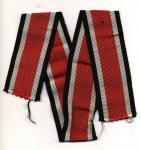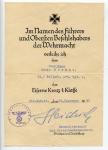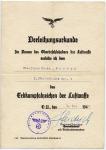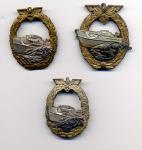-
Posts
2,284 -
Joined
-
Last visited
-
Days Won
6
Content Type
Profiles
Forums
Blogs
Gallery
Events
Store
Everything posted by PKeating
-
I think you are reading too much into the various comments here, Dave. Ed Haynes raised the issue of civilian defence contractors - the euphemism for mercenaries - in a legitimate way and I proposed a possible reason for the apparent restriction of the award to certain categories of civilian defence employees. That falls within the scope of legitimate discussion concerning civilian awards. I suppose you probably see, for instance, the Dick Cheney allusion as out of place but it is no more out of place here than observing, sardonically, that individuals like Margaret Thatcher, actresses and golfers were awarded the Medal of Freedom. It's not "political". It is more of an ironic commentary on the devaluation and degradation of institutions, delivered in a sardonic manner. That is allowable in a discussion of awards and awards criteria, isn't it? PK
-
Indeed! They minted half a million for the planned invasion. Sobering thought... PK
-
Thanks for the replies, gents. So, it looks as if I could indeed have a PH to an African-American KIA, given that a Korean War WIA would have been unlikely to end up with a Philadephia QM Department-engraved PH as prepared and sent to NoK of KIA? PK
-
Very true, Ed. The King's Medal in the Cause of Freedom was also given to some Resistance operatives, as was the US Medal of Freedom. Of course, at a stretch, their activities fell partly under the intelligence umbrella as they were run by or worked in collaboration with Allied secret services. The original Truman and Eisenhower-era medal was indeed rather different in nature to the Kennedy reincarnation. As a matter of interest, here is the text of Gen?vi?ve de Galard-Terraube's citation in 1954: Were Blackwater "security consultants" nominated for the Defence of Freedom Medal for their activities in Iraq, it would set quite an interesting precedent in the modern West in that a Western government would officially be rewarding private mercenaries. Western governments haven't officially employed mercenaries since the Landesknecht. There again, it all depends upon one's definition of "mercenary". One can point to the French Foreign Legion or the Swiss Guard or even the Gurkhas of the British Army. One might even describe the Indian Army of Raj times as a mercenary force because it was, essentially, the army of the Honourable East India Company by another name. But it isn't quite the same. The Landesknecht, like the "security consultants" outnumbering regular soldiers by four to one in Iraq, were lances-for-hire in the purest sense, just as Blackwater's men are guns-for-hire. So they were freebooting mercenaries, just like, say, the men in units made famous in post-colonial Africa by the likes of Bob Denard, Congo M?ller and Mad Mike Hoare. So, making employees or contractors working for Blackwater and Halliburton eligible for the Defence of Freedom Medal would probably bring into sharp focus, amongst other things, Section Nine of UN Resolution 34/44 of 23.11.1979, which states: Hmmmmmm... Anyway, sorry for the digression. I was mildly amused by the idea of making Blackwater and Halliburton gunmen eligible for official US awards. What next? A Presidential Medal of Freedom for ex-Halliburton CEO-turned US Vice-President Dick Cheney? And maybe a Nobel Peace Prize while we are at it... PK
-
Just like the L?gion d'Honneur... P
-
What about the Presidential Medal of Freedom? Harry Truman instituted it as the "US Medal of Freedom" in 1945 to reward civilians for exceptionally meritous service in wartime. Foreigners were eligible as well as Americans and the USMoF was awarded for bravery as well as merit, as the awards to members of resistance organisations like Elaine Delhaye-Gill, Marie Louise Dissard and Andr?e de Jongh in former Occupied Europe for bravery show. Dwight Eisenhower awarded it in 1954 to Genevieve de Galard-Terraube, the French nurse known as the Angel of Dien Bien Phu. Galard-Terraube also received the Bronze Palm. John F Kennedy reactivated it in 1963 as the "Presidential Medal of Freedom" for "especially meritorious contribution to (1) the security or national interests of the United States, or (2) world peace, or (3) cultural or other significant public or private endeavors" (Executive Order 11085 dated Feb. 22, 1963). Foreign recipients include Margaret Thatcher, Lech Walesa and Anwar Sadat. In 2004, Dubya gave it to actress Doris Day and golfer Arnold Palmer. The George Cross has not so far been awarded for services to the screen or golf but give it time... There is also the Congressional Gold Medal. Then there's the Defence of Freedom Medal, described as a "civilian Purple Heart". The first awards will apparently be to civilian employees killed or wounded in the attack on the Pentagon in 2001. It does not look as if this award will be open to civilians who are not employed or contracted by the US Department of Defence so maybe it doesn't count. PK
-

EK 1939 Ritterkreuz ribbon
PKeating replied to PKeating's topic in Germany: All Eras: The Iron Cross
Thanks. However, this is not a debate about the originality or otherwise of this particular riband. Whether this piece of RK riband is wartime or not is actually irrelevant to the question. I simply wanted to know if it were true that EK/RK 1939 riband was made in the 40mm width during WW2. Regarding "orange" tints, I have seen Winterschlact 1941/42 riband on medals said to have been reproduced in the 1960s in Austria, probably by Rudolf Souval. I have never seen this "orange" tint in known original Russian Front ribands on medal bars, tunics, riband bars or loose, original medals. However, I have seen orange-tinted central stripes on 1939 EK2 ribands accepted as wartime. This riband was in a box of bits and pieces which also contained an early Souval RK. It could be of 1960s manufacture. However, a number of people who have experience and common sense and who have seen and handled it have wondered if it might be leftover wartime stock. You do not agree. That's fine. Ribands are not a subject I have studied very closely, being more familiar with the crosses themselves, but this has more in common with wartime riband than modern reproduction riband. I wouldn't say that the "sawcut" was a definitive way of dating riband. I have seen plenty of original ribands for various awards cut from rolls with this kind of tailor's sissors. The ribands themselves were period stock. I do not, however, recall ever observing it with original, unused RK riband folded in presentation cases. Nor is the shortness of a piece of RK riband a reliable indicator, if the riband has clearly been fitted to a cross at some point. My question was simply aimed at establishing whether or not 1939 Iron Cross riband was ever made during the war in the 40mm size. That is all. PK -

EK 1939 Ritterkreuz ribbon
PKeating replied to PKeating's topic in Germany: All Eras: The Iron Cross
I've read Gordon's books. The average length of ribbons supplied with the RK was indeed 72cm or thereabouts. However, many ribbons have been shortened or cut from rolls afterwards. You say "Only early ribbons were "orange" not late ones and no post war like this". I wrote "this ribbon, although the picture hardly shows it, has that subtle orange tint to the red stripe seen on some wartime EK2 ribbon and, indeed, RK ribbon. It's not as orange-tinted as some I have seen but the orange "undertone" is there." The photograph doesn't show it clearly. My question was more about the width: 40mm. Some say that this 40mm ribbon was produced from 1939 to 1945 but never used. You say with total conviction that this is 1957 ribbon. That's fine but what are your sources for this information? PK -
Quite a nice example of the 1943/44 issue FSA d. Heeres. The Army Parachutist Badge was abolished on 1.1.1939 when the Heer's Fallschirm-Infanterie-Bataillon was transferred to Luftwaffe command, becoming II./Fallschirmj?ger-Regiment 1. Prior to then, Brandenburg paratroopers had received the Luftwaffe Parachutist Badge. The Brandenburg Division began as a Special Purpose Battalion, the Bau-Lehr-Bataillon zbV 800, formed on 15.12.1939 to carry out special operations and sabotage. These special purpose troops were based near Berlin, in Brandenburg, hence the nickname that would become part of their official unit designation. The first Brandenburg paras comprised a small detachment under the command of a sergeant and reported for jump training in February 1940. In May 1940, the battalion became the Brandenburg-Lehr-Regiment zbV 800 and the para-trained elements were formed into a platoon, based at Stendal under Leutnant L?tke, as part of the 4th Company of the regiment?s 1st Battalion. The Brandenburg paras? first airborne mission as a unit came on 25.6.1941, in the opening stages of the invasion of the USSR, when the parachute platoon jumped and secured two railway bridges on the Lido-Molodechno line. Increased to company strength that autumn, the platoon became the 1st Battalion?s 4th (Parachute) Company, under the command of Leutnant K?rschner and, later, Leutnant Gerlach. Brandenburgers of 15. (Fallschirm) Kompanie on patrol somewhere in Bosnia in 1943 With the formation of the Brandenburg Division - which still retained the special purpose designation ?zbV 800? in its title - in Germany in April 1943, the airborne company was reformed as 15 (Parachute) Coy, 3rd Bn, 4th Light Infantry Regiment, Brandenburg Division zbV 800. The 4th Regt was posted to Yugoslavia on 17.4.1943, on attachment to the 1st Mountain Division based at Sjenica. As in Russia, they found themselves embroiled in brutal anti-partisan warfare. With the 4th Regiment?s subsequent move in October to Sarajevo to disarm Italian forces there, 15 (Parachute) Coy moved to a new base at the Mataruska Banja airfield outside Kraljevo, about 200 km to the east, where the Luftwaffe had relocated Fallschirmschule III to train members of the newly-formed SS-Fallschirmj?ger-Bataillon 500, which was forming up in nearby Kraljevo at the same time. Members of 15. (Fallschirm) Kompanie duly received the Heer badge upon completion of their jump training. A member of 15. (Fallschirm) Kompanie on the Greek island of Leros in November 1943 In February 1944, Fallschirmj?ger-Bataillon "Brandenburg" was formed at Stendal under the command of Hauptmann Weith?ner, while 15 (Fallschirm) Kompanie remained on the order of battle as an independent sub-unit under Oberleutnant Oschatz. The badges were supplied by the Berlin firm of C E Juncker, who had made the Army Parachutist Badge before the war, in 1937 and 1938. They were struck in feinzink on the same dies used to produce the Type 2 badges in aluminium and, for private purchase, 800 silver. Enough badges were made for the battalion and the independent parachute company. In this colorised portrait of Walter Scheu, to which a studio artist has added decorations earned after the photograph was taken in March 1944, we see the Army Parachutist Badge. This is the only known wartime image of a Waffen-SS soldier wearing the FSA d. H. I have been searching for some years for a proper photograph showing the badge on a Waffen-SS paratrooper but have so far only turned up photographs showing the Luftwaffe badge. Scheu never received an award document but he did receive a military parachutist's licence and the badge is recorded in his paybook. I have seen two award documents to surviving veterans as well as another paybook containing mention of the FSA d. H. However, the majority of Waffen-SS paratroopers appear to have been given the Luftwaffe pattern badge, indicating that insufficient quantities were supplied to cover SS-Fallschirmj?ger-Btl 500 as well as Fallschirmj?ger-Btl "Brandenburg" and 15. (Fallschirm) Kompanie. In other words, the 1943/44 badges are as rare as their 1937/38 counterparts. Moreover, in August 1944, two companies of FJ-Btl Brandenburg participated in the ill-fated ?Relief of Bucharest?. The aim was to rescue two generals ? and their troops - whose HQ was encircled by pro-Soviet Romanian forces. A small force of Brandenburg paras seized Bucharest?s Otopeni Airport at midday on August 24th and held it until 1900 hrs, when their comrades began arriving in Me 323 Gigants. By 2100 hrs, the airport and encircled German HQ areas were under German control. Negotiations with the Romanians, some of whom still professed loyalty to their German allies, secured promises that German forces in and around Bucharest would have safe passage to the Yugoslav border. But all pretence of any cooperation ended on September 1st. As the German column was leaving Bucharest, protected by Brandenburgers, the Romanians turned them over to the Soviets. The ORBAT of FJ-Btl Brandenburg was reduced by half as a result of the Bucharest mission. Few if any of the Brandenburgers survived Soviet captivity and several hundred examples of an already scarce badge must have disappeared with them. As a footnote, this example came with a 1982 Lothar Hartung Certificate of Authenticity. Herr Hartung was actually officially qualified to authenticate orders and decorations, unlike some of the charlatans charging for CoAs today. As with the prewar aluminium badges, it is unlikely that there were more than three or perhaps four minimum production runs of five hundred units each. No original feinzink APB has ever been encountered with a Juncker hallmark. The hinge and hook assembly was exactly the same as that used on Juncker flight qualification badges made in feinzink or pot metal, the smaller barrel hinge mounted on an oblong base and the hook on a circular base to make the soldered joints stronger. Original examples have been observed with hooks fashioned from round and flat wire stock. The CoA is not terribly relevant as the badge is obviously original but it is an interesting addition nonetheless because it shows that people did know the difference between originals and fakes back then! PK
-

EK 1939 Ritterkreuz ribbon
PKeating replied to PKeating's topic in Germany: All Eras: The Iron Cross
Thanks for the reply. Interesting about the Lazy 2 Juncker RK with the 40mm ribbon. This length of ribbon conforms to what I would expect of period ribbon, which is to say of manufacture pre-dating the end of the Third Reich, but ribbon made in the late 1950s would be very hard to identify when compared to 1940s stock. That said, this ribbon, although the picture hardly shows it, has that subtle orange tint to the red stripe seen on some wartime EK2 ribbon and, indeed, RK ribbon. It's not as orange-tinted as some I have seen but the orange "undertone" is there. PK -
Here is another late-war award to a US Army KIA. I would say that it was named on the same machine as mine! Yet the fellow who contacted me was adamant that my Purple Heart bears 1950s-style naming. I take his point about the diminutive form of the forename, that the QM Department would have engraved the medal with Thompson's name as it appeared in their records. So, is this a Korean War WIA award or a WW2 KIA award? The supplementary photos came from a couple of websites recommended by the gentleman who contacted me. According to his assertions about the naming style, this WW2 PH to Donald Childers was named up in the 1950s. PK
-
The medal is impressed to "Eddie M Thompson". There is a middle initial. There are two Edward M. Thompsons listed as KIA in WW2: THOMPSON EDWARD M SGT 32143986 16-Nov-44 FL THOMPSON EDWARD M TEC5 19173701 27-May-45 ML Edward M. Thompson Sergeant, U.S. Army Service # 32143986 371st Infantry Regiment 92nd Infantry Division Entered the Service from: New York Died: 16-Nov-44 Buried at: Plot B Row 5 Grave 45 Florence American Cemetery Florence, Italy Awards: Purple Heart I acquired it from a friend who knows I am interested in African-American militaria. I showed it on another forum at the time and was contacted by a Purple Heart collector who told me that he was sure it was a Korea award to one Eddie M Thompson. He stated: The medal itself is a Type 3 unnumbered issue dating from 1943 to 1945. So many Purple Hearts were delivered to the US Army in anticipation of heavy casualties during the planned invasion of Japan that no more were supplied until 1970. So it could be a Korea issue. However, having looked into this a little more, my studies indicate the the type of naming on the reverse of this PH is known by PH collectors as "small blackened machine engraving", which is one of four distinctive styles seen on Purple Hearts issued by the Philadelphia Quartermasters Department to the next-of-kin of posthumous recipients. Furthermore, a casual study of late-WW2 posthumous awards from October 1944 onwards shows identical naming to that on the "Eddie M. Thompson" Purple Heart in my possession. Below are some examples of Purple Hearts to US Army KIA late in WW2.
-
-
I'd heard and read of 40mm RK ribbon but had never seen any until this 50.5 cm piece came my way. Paddy Keating
-
A classic 2nd Class Iron Cross award document for Monte Cassino to Obergefreiter Viktor Wollner of 3./Fallschirmj?ger-Regiment 1. Wollner was a member of the FJR1?s 1st Battalion. The document bears the stamp of 1. Fallschirmj?ger-Division and the stamp signature of the divisional commander Richard Heidrich. It has been folded over twice, indicating that it was carried in the recipient?s paybook. PK
-
Not at all! What you have written is very interesting to me! I knew a man in London who was one of the organisers of the FFL S?ction Grande Bretagne. He had been some kind of acrobat at the Cirque d'Hiver but was a bit of a "bad boy" on the side. He told me he enlisted in the L?gion to "disappear" and that he said he was Belgian. Maybe he meant the Bat d'Af! Anyway, all was forgotten and forgiven when I knew him as we used to go to the French Embassy for FFL--related events together. I have sent you a PM. Our meeting is long-overdue! P
-
http://www.anacr.com/ The Association Nationale des Anciens Combattants de la R?sistance (ANACR) was founded in March 1945 by members of the Gaullist FFI (Forces fran?aises de l'int?rieur) and the predominantly Communist FTP (Franc-tireurs partisans), sometimes known as France-tireurs partisans communistes or France-tireurs partisans fran?aise, depending on how radical a given unit's politics were. The ANACR name was adopted in 1952. This veterans' organisation was born of an attempt to unite the various factions, which remained splintered during and after the war, despite the best efforts of some Resistance leaders. The Gaullists have sometimes been accused of airbrushing the FTP and other non-FFI groups out of the picture and there is perhaps some truth in the allegations levelled by FTP veterans. For instance, it is very hard to find published information on the so-called Battle of Saint-Denis, when FTP units engaged heavily armed German convoys in that northern Parisian suburb in August 1944. In the fierce house-to-house fighting, which involved Fallschirmj?ger and armoured units, the centre of Saint-Denis - around the crossroads of the Route Nationale 1, a main withdrawal route for German units retreating from the Paris area and the Seine and Oise valleys - was flattened and resembled Stalingrad or Grozny. Old buildings are rare in the area. Yet nobody speaks of it, to the chagrin of FTP veterans I know who fought there. I also interviewed a former German paratrooper who met the FTP in Saint-Denis and on the edges of the Montmorency Forest and he said they were formidable fighters. Many were veterans of Spain, of the L?gion (French bad boys who pretended to be Belgians to get in!) and of the War of 1939-1940. Anyway, get in touch with the ANACR. Let me know if you need any help with the language. PK
-

Uncategorised Urkunde
PKeating replied to Kepi blanc's topic in Germany: Third Reich: Research, Documentation & Photographs
Hmmmmmmm... -

EK 1939 Godet Knights Cross Opinions
PKeating replied to philsidey's topic in Germany: All Eras: The Iron Cross
Indeed. PKA numbering appears to have been adopted in 1944 although it could have been a bit earlier. LDO numbering came in in 1941. I think Pieter does have one of these sets but I don't know whether it's the set with the RK and two 1939 Bars or one of the others. Never asked him. PK -

EK 1939 Godet Knights Cross Opinions
PKeating replied to philsidey's topic in Germany: All Eras: The Iron Cross
As far as I concerned, Zimmermann supplied the components and that probably included the riband loop. The Zimmermann RK I had - which now lives with Pieter Verbruggen - had the ovaloid loop with L/52 and 900 marks. The cross was unmarked. It's impossible to prove fully but I think the fact that the high end fake Ritterkreuze supplied by the Godet firm to various high end dealers in the 1960s and 1970s look nothing like known original Zimmermann/Godet crosses suggests that Zimmermann held the dies and tooling. If Godet had been the maker from 1939 to 1945, there would be as many Zimmermann/Godet RK out there as Steinhauer & L?ck RK. Had the tooling suvived the war, like the S&L and Klein & Quenzer tooling, Frau Klietmann would used it as she used Godet's other tooling. This is why I am convinced that the crosses were made by Zimmermann. It could be that Godet bought in the components and assembled them but I would want to see a known Godet cross up close before accepting this as probable rather than possible. The Zimmermann RK I have owned or examined were all of a high standard in terms in manufacturing and finish quality, with the exception of the several examples that came to light a while ago, all of which were fire-damaged and a couple of which were "restored". In more than thirty years, nobody has ever been able to show me an RK identifiable as a Godet cross...as opposed to a Zimmermann cross. Old photographs from Dr Klietmann's archives of the cased sets presented by Hitler to various high-ranking officers after the 1940 campaigns show RK that are obviously of the Zimmermann/Godet type, complete with the characteristic ovaloid riband loops. It is reasonable to presume that these sets were supplied to the PKA by Godet, given the appearance of the cases. However, I have never examined a known, original cased set of this nature personally, so I do not know if the cases or the lower grade awards bore any Godet trademarks. PK -

Kriegsmarine Bacqueville u-boat badge
PKeating replied to paul w's topic in Wehrmacht Medals, Decorations & Awards
But here's an indisputably untouched Bacqueville E-Boat Badge with a nice age patina, pictured with a Schwerin 1st pattern badge and an Adolf Scholtz 2nd pattern badge. PK -

Kriegsmarine Bacqueville u-boat badge
PKeating replied to paul w's topic in Wehrmacht Medals, Decorations & Awards
This finish looks new but appears to be original. If you looks at the previous two badges, you can see that someone appears to have painted the wreaths carelessly. I suppose it was the dealer's assistant, trying to finish dozens of badges before going home! PK










